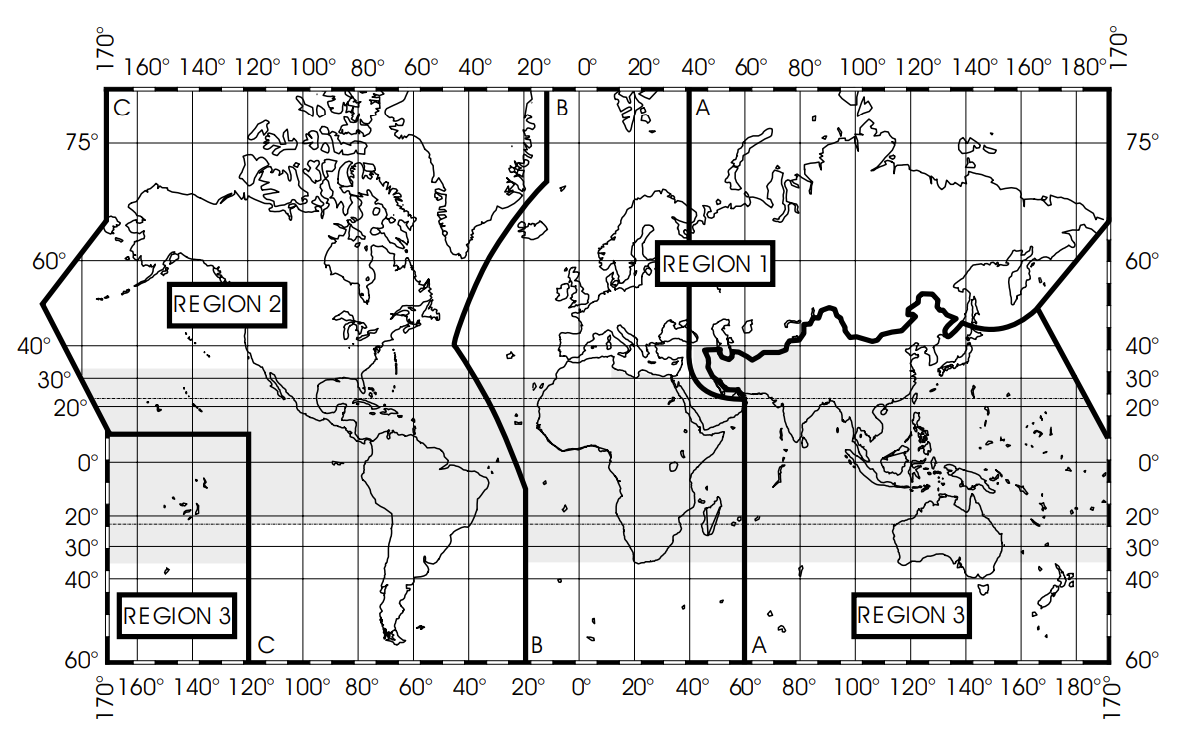 ITU Secretary-General, Doreen Bogdan-Martin, addressing WRC-23
ITU Secretary-General, Doreen Bogdan-Martin, addressing WRC-23
Courtesy: ITU

FCC Chairwoman, Jessica Rosenworcel; ITU Telecommunication Development Bureau Director, Cosmas Zavazava; ITU Telecommunication Standardization Bureau Director, Seizo Onoe; ITU Radiocommunication Bureau Director, Mario Maniewicz; Director General H. E. Engineer Majed Sultan Al Mesmar; ITU Secretary-General, Doreen Bogdan-Martin; and various UAE officials observing WRC-23 proceedings (from left to right)
Courtesy: ITU

ITU Secretary-General, Doreen Bogdan-Martin; Deputy U.S. Chief Technology Officer for Policy, Austin Bonner; FCC Commissioner, Geoffrey Starks (speaker); Commerce and State Department officials; and U.S. WRC-23 Ambassador Steve Lang welcoming WRC-23 delegates at the U.S. reception (from left to right)
Courtesy: Hogan Lovells
The ITU has published WRC-23’s decisions as Provisional Acts and will release the Final Acts in 2024 after completing editorial revisions. Below is a summary of the significant WRC-23 decisions and future agenda items for consideration at WRC-27 and WRC-31.
WRC-23 Results
WRC-23 decided on changes affecting numerous telecommunications sectors, and in particular the satellite sector, as well as future WRC agenda items. Below are brief highlights with additional details appearing in the tables following this summary.
International Mobile Telecommunications (IMT). Identified various bands between 3300 MHz and 10.5 GHz for IMT, particularly for terrestrial 5G and 6G service.
High-Altitude Platform Stations as IMT Base Stations (HIBS). Identified various bands between 694 MHz and 2690 MHz for HIBS.
Global Maritime Distress and Safety System (GMDSS). Introduced, among other things, new Chinese GSO satellites (BeiDou Message Service System) into the GMDSS in 1614.4225-1618.725 MHz, 1616.3-1620.38 MHz (Earth-to-space), and 2483.59-2499.91 (space-to-Earth) subject to coordination and further ITU and WRC review.
Satellites. Adopted regulatory provisions, allocations, and future studies for various satellite use cases.
-
Earth Stations in Motion (ESIMs). Finalized globally harmonized regulatory provisions governing aeronautical and maritime fixed-satellite service (FSS) ESIMs in 12.75-13.25 GHz (Earth-to-space) with geostationary orbit (GSO) FSS networks and in 17.7-18.6 GHz, 18.8-19.3 GHz, and 19.7-20.2 GHz (space-to-Earth) and 27.5-29.1 GHz and 29.5-30 GHz (Earth-to-space) with a non-geostationary orbit (NGSO) FSS network or system.
-
New allocations. Added a –
-
(1) space research service allocation in 14.8-15.35 GHz (space-to-space, space-to-Earth, and Earth-to-space) on a primary basis except the new service allocation remains secondary with respect to terrestrial services in various countries, including the United States;
-
(2) inter-satellite service allocation in 18.1-18.6 GHz, 18.8-20.2 GHz, and 27.5-30 GHz for space research, space operation, and/or Earth exploration-satellite applications and data transmissions originating from industrial and medical activities in space; and
-
(3) FSS allocation in 17.3-17.7 GHz FSS (space-to-Earth) for GSO and NGSO operations in Region 2 (see ITU regional breakdown below).
-
Orbital tolerances. Adopted permissible deviations from the orbital altitudes and inclinations that have been notified to the ITU by NGSO FSS, mobile-satellite service (MSS), and broadcasting-satellite service (BSS) satellites in the 10.7-51.4 GHz frequency range.
-
Constellation deployment milestone reporting. Adopted reporting obligations for the orbital characteristics of NGSO FSS, MSS, and BSS satellites in the 10.7-51.4 GHz frequency range after completing constellation deployment milestones with the first notification occurring 11 years after the after the 7-year regulatory bringing-into-use deadline and subsequent notifications occurring every 4 years afterwards.
-
Aggregate EPFD. Supported development of a methodology to calculate and model NGSO FSS systems’ aggregate co-frequency equivalent power flux-density (EPFD); and agreed that administrations operating or planning to operate NGSO FSS systems shall hold consultative meetings on a regular basis (e.g., yearly) to ensure GSO FSS or GSO BSS network protection from NGSO FSS systems.
Future agenda items. Following are some agenda items that WRC-23 agreed to address at WRC-27.
-
IMT. Spectrum identifications in the frequency bands 4400-4800 MHz, 7125-8400 MHz (or parts thereof), and 14.8-15.35 GHz for next generation terrestrial mobile services, such as 5G and 6G
-
FSS. Regulatory provisions for aeronautical and maritime V-band FSS ESIMs, small FSS antennas in Ku-band, and radio astronomy protection specifically in Radio Quiet Zones (RQZs) from aggregate NGSO FSS radiofrequency interference; allocations for NGSO FSS in 51 GHz and FSS in 17 GHz for Region 3, as well as 17 GHz EPFD requirements for Regions 1 and 3; and equitable access or band planning for V-band FSS networks or systems
-
MSS. Allocations for MSS space-to-space links in 1518-2483.5 MHz; low-data-rate NGSO MSS in 1427-2025 MHz; direct-to-device MSS connectivity in 694/698-2700 MHz (bands identified for terrestrial IMT in Rec. ITU-R M.1036); and standard MSS in 2010-2170 MHz
-
Lunar. Frequency-related matters, including possible new or modified space research service (space-to-space) allocations for future development of communications on the lunar surface and between lunar orbit and the lunar surface
-
70/80 GHz changes. Satellite power limits to protect co-frequency E-band terrestrial services; satellite and terrestrial limits to protect adjacent E-band Earth exploration-satellite service (passive) and the radio astronomy service
-
Other. Limits on unauthorized NGSO FSS and MSS earth stations
WRC-23 opted for no change regarding sub-orbital vehicles, uncrewed aircraft system (UAS) command-and-control links’ use of GSO FSS networks, narrowband MSS allocations, and single-entry EPFD future studies.
RA Results
Before WRC-23, the associated Radiocommunication Assembly (RA) met. The RA handles the structure, program, and approval of radiocommunication studies supporting WRC actions. Below are the notable RA-23 adoptions:
-
"IMT-2030" as the technical reference for 6G;
-
new Recommendation ITU-R M.2160 on the "IMT-2030 Framework" for IMT-2030 development;
-
new Resolution ITU-R 73 on use of IMT technologies for fixed wireless broadband in the frequency bands allocated to the fixed service on a primary basis; and
-
new Resolution ITU-R 74 on space sustainability for long-term sustainable use of radio-frequency spectrum and associated NGSO satellite orbit resources (with immediate focus on creation of a related handbook and ITU website page containing a compendium of related links).
For additional coverage, visit the ITU RA-23 press release.
APPENDIX A (ITU-R Regions)
The ITU aims to globally harmonize radiofrequency allocations. But occasionally, it adopts regional radiofrequency allocations. The following illustration depicts the three ITU-R regions. In general, Region 1 covers Europe, Africa, and Russia; Region 2 covers the Americas; and Region 3 covers Asia and Oceania.

APPENDIX B (WRC-23 Results)
APPENDIX C (WRC-27 Agenda)
APPENDIX C (WRC-31 Preliminary Agenda)